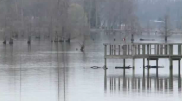'Japan Is No Chernobyl': Comparing Two Level-7 Nuclear Disasters
Now that Japan's nuclear crisis level has risen to 7, the highest rating possible, media outlets around the world have been quick to compare the ongoing emergency at Fukushima with the disaster that struck Chernobyl in April 1986.
Up until this point, Chernobyl was the only disaster to be labeled a 7, which entails a “major release of radioactive material with widespread health and environmental effects," according to International Nuclear and Radiological Event Scale (INES).
Oddly enough, despite having matching severity ratings, officials continue to claim “Japan is no Chernobyl.”
Is that true? Well, yes and no.
Even in the earliest articles, reports highlighted the fact that the Japan power plant incident was caused by an unavoidable natural disaster, whereas Chernobyl is generally believed to have been caused by human error. Because of that significant difference, the problems of both disasters were unique to each situation.
The Chernobyl incident occurred while the reactor itself was still active, creating an explosion that caused a graphite fire and a cloud of radiation that contaminated large areas of Europe.
At Fukushima, a massive earthquake and subsequent tsunami struck the plant and damaged its cooling system, but the plant still has mostly intact containment vessels surrounding its nuclear cores. Japan officials maintain that, since the nuclear substance is still within its original containers, less radiation has been released and the threats to public health are less severe.
According to TIME, Japan's Nuclear and Industrial Safety Agency (NISA) officials emphasized that radiation released from Fukushima totaled only one-tenth of what Chernobyl emitted.
In actual figures, that’s between 370,000 and 630,000 terabecquerels of radioactive iodine-131, compared to the 5.2 million terabecquerels released in Chernobyl. However, based on the time of exposure and level of proximity, it's enough radiation to cause thyroid disease in humans. If it spreads to the environment, it can contaminate water systems and the food chain of an entire ecosystem.
And some worry the battle is far from over. The Washington Post reported an official from the Tokyo Electric Power Co. saying at a separate conference that the leakage still hadn’t been fully stabilized yet:
“Our concern is that the amount of leakage could eventually reach that of Chernobyl or exceed it.”
According to Gerald Karch, chief executive of concrete manufacturer Putzmeister, Japan may even be more problematic than Chernobyl. Karch told Reuters that while no official decision had been made, encasing parts of the Fukushima plant in concrete would be the most sensible solution. To put the amount of work needed in perspective, he compared the amount of concrete trucks in use between the disasters, saying:
"In Chernobyl, where a single reactor was encased, 11 trucks were in action for a number of months. In Fukushima we're talking about four reactors.”
It’s a big problem to solve for such a small group of power plant workers most of the world knows so little about. For those workers, it’s also a race against time as scientists continue to assess the disaster’s potential effects on human life.
According to the International Atomic Energy Agency, around 100,000 people were exposed to radiation from the Chernobyl disaster. The total number of deaths already attributable to Chernobyl, or expected in the future, is estimated to be about 4,000 -- and most who died were either workers or involved with cleanup.
At Fukushima, about 21 plant workers have been affected by minor radiation sickness so far, says Japanese officials. It is not yet known how many more will die.
When it comes to saving lives, both disasters illustrate the utmost heroism; workers both in Japan and the former Ukrainian SSR risked their safety to contain the reactors.
One mother of Japan’s “Fukushima 50” said her son had completely committed himself to the job:
"He told me they have accepted they will all probably die from radiation sickness in the short term or cancer in the long-term."
Anatoly Tkachuk, a senior official at Chernobyl when its No. 4 reactor blew up in 1986 told a similar story, reports Reuters:
"We immediately felt pain in the throat -- the first sign of a high radiation dose -- and headaches, pressure in the head, very painful joints, especially the knees. The chances of coming back were slim. We had already said goodbye to the world.”
But not all actions were seen as noble. Former Fukushima Gov. Eisaku Sato comments on the disturbing similarities between the ways both Japan’s and the Soviet Union’s governments dealt with the crisis, reports the Wall Street Journal:
“The situation that we see in Japan now with nuclear power policy is very similar to what happened with Chernobyl. In other words, it’s almost as though we are in a fascist country where information is hidden from the public. I believe that this is time for Japan to wake up and see what the situation is.”





